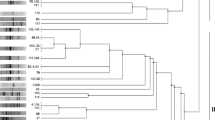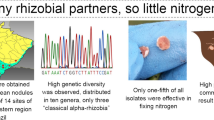Abstract
Parasponia remains the only non-legume known to nodulate withRhizobium/Bradyrhizobium. It is a pioneer plant that is capable of rapid growth and fixing large quantities of nitrogen. In addition to its high agronomic potential, the symbiosis offers the scientist the unique opportunity of studying differences at the molecular level of both partners, and to investigate any possible extension of the symbiosis to other non-legumes of importance. Haemoglobin has been found in the nodule tissue ofParasponia and other nodulated non-legumes and the gene for it has been found and expressed in non-nodulating plants such asTrema tomentosa andCeltis australis. Bradyrhizobium strains isolated from species ofParasponia growing in Papua New Guinea form a group that are more specific in their host requirements thanBradyrhizobium strains from tropical legumes from the same area. They do not effectively nodulate (except CP283) tropical legumes, andParasponia is not readily nodulated withRhizobium andBradyrhizobium strains from legumes. The effectiveness of the symbiosis is influenced by host species, theBradyrhizobium strain and the environment.Parasponia andersonii forms a more effective symbiosis than the other species tested. In competition studies with strains from legumes, isolates fromParasponia always dominate in nodules onParasponia.
Similar content being viewed by others
References
Akkermans A D L, Abdulkadir S and Trinick M J 1978 N2-fixing root nodules in Ulmaceae:Parasponia or (and)Trema spp.? Plant and Soil 49, 145–149.
Appleby C A, Bogusz D, Dennis E S, Dudman W F, Fleming A I, Higgins J, Kortt A A, Landsmann J, Peacock W J, Tjepkema J D, Trinick M J, Wittenberg B A and Wittenberg J B 1986 The origin and survival of plant haemoglobin genes.in Proceedings of the 8th Australian Legume Nodulation Conference, held in association with The Australian Institute of Agricultural Science, AIAS Occasional Publication No 25, p77.
Appleby C A, Tjepkema J D and Trinick M J 1983 Haemoglobin in a non-legume plant,Parasponia: Possible genetic origin and function in nitrogen fixation. Science 220, 951–953.
Athar M and Mamood A 1981 Extension ofRhizobium host range to Zygophyllaceae.In Current Perspectives in Nitrogen Fixation. Eds. A H Gibson and W E Newton. p. 481. Aust. Acad. Science, Canberra.
Becking J H 1983 TheParasponia parviflora — Rhizobium symbiosis: Host specificity, growth and nitrogen fixation under various conditions. Plant and Soil 75, 309–342.
Bogusz D, Appleby C A, Landsmann J, Dennis E S, Trinick M J and Peacock J W 1988 Functioning haemoglobin genes in non-nodulating plants. Nature (London) 331, 178–180.
Faria S M de, McInroy S G and Sprent J I 1987 The occurrence of infected cells, with persistent infection threads, in legume root nodules. Can. J. Bot. 65, 553–558.
Faria S M de, Sutherland J M and Sprent J I 1986 A new type of infected cell in root nodules ofAndira spp. (Leguminosae). Plant Sci. 45, 143–147.
Fleming A I, Wittenberg J B, Wittenberg B A, Dudman W F and Appleby C A 1987 The purification, characterisation and lignand binding kinetics of hemoglobins from root nodules of the non-leguminousCasuarina glauca-Frankia symbiosis. Biochim. Biophys. Acta (in press).
Herridge D F 1982 Assessment of nitrogen fixation.In Nitrogen Fixation in Legumes. Ed. J M Vincent. pp 123–136. Academic Press.
Hirsch A M, Drake D, Jacobs T W and Long S R 1985 Nodules are induced on alfalfa roots byAgrobacterium tumefaciens andRhizobium trifolii containing small segments of theRhizobium meliloti nodulation region. J. Bacteriol. 161, 223–230.
Hrabek E M, Truchet G L, Dazzo F B and Govers F 1985 Characterization of the anomalous infection and nodulation of subterranean clover roots byRhizobium leguminosarum. 1020. J. Gen. Microbiol. 131, 3287–3302.
Jordan J D 1982 Transfer ofRhizobium japonicum Buchanan 1980 toBradyrhizobium gen. mov., a genus of slow-growing root nodule bacteria from leguminous plants. Inst. J. System. Bacteriol. 32, 136–139.
Lancelle S A and Torrey J G 1984 Early development ofRhizobium-induced root nodules ofParasponia rigida I. Infection and early nodule initiation. Protoplasma 123, 26–37.
Landsmann J, Dennis E S, Higgins T J V, Appleby C A, Kortt A A and Peacock W J 1986 Common evolutionary origin of legume and non-legume plant haemoglobins. Nature 324, 166–168.
Marvel D J, Torrey J G and Ausubel F M 1987Rhizobium symbiotic genes required for nodulation of legume and nonlegume hosts. Proc. Nat. Acad. Sci. USA 84, 1319–1323.
Scott K F 1986 Conserved nodulation genes from the nonlegume symbiontBradyrhizobium sp. (Parasponia). Nucleic Acid Res. 14, 2905–2919.
Soepadmo E 1977 Ulmaceae.In Flora Malesiana Ser. 1, vol. 8. Ed. C G G J van Steenis. pp 31–76. Noordhoff n.y. Jakarta.
Tjepkema J D 1983 Hemoglobins in the nitrogen-fixing root nodules of actinorhizal plants. Can. J. Bot. 61, 2924–2929.
Trinick M J 1979 Structure of nitrogen fixing root nodules formed onParasponia andersonii Planch. Can. J. Microbiol. 25, 565–578.
Trinick M J 1980a Growth ofParasponia in agar tube culture and symbiotic effectiveness of isolates fromParasponia sp.. New Phytol. 85, 37–45.
Trinick M J 1980b Effects of oxygen, temperature and other factors on the reduction of acetylene by root nodules formed byRhizobium onParasponia andersonii Planch. New Phytol. 86, 27–38.
Trinick M J 1981 The effective rhizobium symbiosis with the non-legumeParasponia andersonii.In Current Perspectives in Nitrogen Fixation. Eds. A H Gibson and W E Newton. p 480. Aust. Acad. Science, Canberra.
Trinick M J 1982 Biology.In Nitrogen Fixation, volume 2. Ed. W J Broughton. pp. 76–146. Oxford University Press, New York.
Trinick M J 1987Bradyrhizobium of the non-legume,Parasponia.In Microbiology in Action, a tribute to James M. Vincecnt, held at the Sydney University July, 1986. Eds. I R Kennedy and W G Murrell. John Wiley and Sons, U.K. In press.
Trinick M J and Appleby C A 1984 The rhizobia ofParasponia. In The Seventh Australian Legume Nodulation Conference, held in association with the Australian Institute of Agricultural Science, AIAS Occasional Publication No 12. pp 87–88.
Trinick M J and Galbraith J 1980 TheRhizobium requirements of the non-legumeParasponia in relationship to the crossinoculation group concept of legumes. New Phytol. 86, 17–26.
Trinick M J and Hadobas P A 1986 Nodulation ofTrifolium repens with naturally modifiedRhizobium fromParasponia. In The Eighth Australian Legume Nodulation Conference, held in association with the Australian Institute of Agricultural Science, AIAS Occasional Publication No 25, pp 87–88.
Vietmeyer N and Cottom B 1977 Leucaena — Promising Forage and Tree Crop for the Tropics. National Academy of Sciences. Washington, D.C.
Vincent J M 1980 Factors Controlling the Legume —Rhizobium Symbiosis.In Nitrogen Fixation. Volume 11. Eds. W E Newton and W H Orme-Johnson. pp. 103–129.
Author information
Authors and Affiliations
Rights and permissions
About this article
Cite this article
Trinick, M.J., Hadobas, P.A. Biology of theParasponia-Bradyrhizobium symbiosis. Plant Soil 110, 177–185 (1988). https://doi.org/10.1007/BF02226797
Issue Date:
DOI: https://doi.org/10.1007/BF02226797




